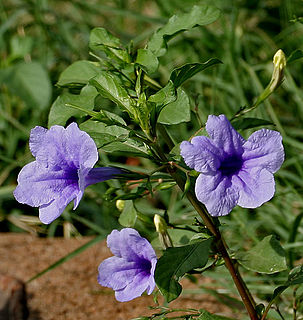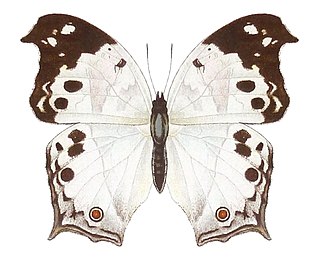
The International Union for Conservation of Nature (IUCN) Red List of Threatened Species, founded in 1964, is the world's most comprehensive inventory of the global conservation status of biological species. It uses a set of precise criteria to evaluate the extinction risk of thousands of species and subspecies. These criteria are relevant to all species and all regions of the world. With its strong scientific base, the IUCN Red List is recognized as the most authoritative guide to the status of biological diversity. A series of Regional Red Lists are produced by countries or organizations, which assess the risk of extinction to species within a political management unit.

Impatiens glandulifera is a large annual plant native to the Himalayas. Via human introduction it is now present across much of the Northern Hemisphere and is considered an invasive species in many areas. Uprooting or cutting the plants is an effective means of control.

Nepenthes glandulifera is a species of pitcher plant endemic to the Hose Mountains of central Sarawak. This plant is so named for the black speckles around the petioles. The species's discoverer, Ch'ien Lee, initially thought they were a sign of disease. After further investigation, it was realised that the black speckles were actually nectar glands. The species is also notable for having a very prominent indumentum. It appears to be closely related to N. pilosa. Nepenthes glandulifera is not known to form natural hybrids with any other species.

Ruellia is a genus of flowering plants commonly known as ruellias or wild petunias. They are not closely related to petunias (Petunia) although both genera belong to the same euasterid clade. The genus was named in honor of Jean Ruelle, herbalist and physician to Francis I of France and translator of several works of Dioscorides.

Hypolimnas misippus, the Danaid eggfly, mimic, or diadem, is a widespread species of nymphalid butterfly. It is well known for polymorphism and mimicry. Males are blackish with distinctive white spots that are fringed in blue. Females are in multiple forms that include male-like forms while others closely resemble the toxic butterflies Danaus chrysippus and Danaus plexippus.

Asystasia gangetica is a species of plant in the family Acanthaceae. It is commonly known as the Chinese violet, coromandel or creeping foxglove. In South Africa this plant may simply be called asystasia.

Anisus vorticulus is a species of minute, air-breathing, freshwater snail, an aquatic gastropod mollusk in the family Planorbidae, the ramshorn snails.

The genus Asystasia belongs to the family Acanthaceae and comprises approximately 70 species found in the tropics, including the weedy species Asystasia gangetica.

Asystasia mysorensis is an edible plant species in the family Acanthaceae found in Africa. It is used as a leafy vegetable and for animal fodder.
Jungia glandulifera is a species of flowering plant in the family Asteraceae. It is found only in Ecuador. Its natural habitat is subtropical or tropical moist montane forests. It is threatened by habitat loss.
Psychotria glandulifera is a species of plant in the family Rubiaceae. It is endemic to Sri Lanka.

Protogoniomorpha anacardii, the clouded mother-of-pearl, is a species of Nymphalidae butterfly found in tropical Africa.

The World's 25 Most Endangered Primates is a list of highly endangered primate species selected and published by the International Union for Conservation of Nature (IUCN) Species Survival Commission (SSC) Primate Specialist Group (PSG), the International Primatological Society (IPS), Global Wildlife Conservation (GWC), and Bristol Zoological Society (BZS). The IUCN/SSC PSG worked with Conservation International (CI) to start the list in 2000, but in 2002, during the 19th Congress of the International Primatological Society, primatologists reviewed and debated the list, resulting in the 2002–2004 revision and the endorsement of the IPS. The publication was a joint project between the three conservation organizations until the 2012–2014 list when BZS was added as a publisher. The 2018–2020 list was the first time Conservation International was not among the publishers, replaced instead by GWC. The list has been revised every two years following the biannual Congress of the IPS. Starting with the 2004–2006 report, the title changed to "Primates in Peril: The World's 25 Most Endangered Primates". That same year, the list began to provide information about each species, including their conservation status and the threats they face in the wild. The species text is written in collaboration with experts from the field, with 60 people contributing to the 2006–2008 report and 85 people contributing to the 2008–2010 report. The 2004–2006 and 2006–2008 reports were published in the IUCN/SSC PSG journal Primate Conservation,, since then they have been published as independent publications.

Herpetogramma licarsisalis, the grass webworm or pale sod-webworm, is a moth of the family Crambidae. It is native to most of the old world tropics, including New Zealand, Hong Kong and Queensland. It is an introduced species in many other parts of the world, including Hawaii and the Canary Islands, as well as India and Sri Lanka
Asystasia alba is a species of tropical herb in the family Acanthaceae. It is endemic to Christmas Island, an Australian territory in the north-eastern Indian Ocean. Its specific epithet comes from the Latin alba (white), referring to the colour of its flowers.

Junonia stygia, the brown pansy, dark pansy or Aurivillius' brown pansy, is a butterfly in the family Nymphalidae. It is found in Senegal, Guinea-Bissau, Guinea, Sierra Leone, Liberia, Ivory Coast, Ghana, Togo, Nigeria, Cameroon, Gabon, the Republic of the Congo, the Central African Republic, Angola and the Democratic Republic of the Congo. The habitat consists of forests, including disturbed areas and secondary forests.

Eretis lugens, the savanna elf, is a butterfly in the family Hesperiidae. It is found in Senegal, northern Guinea, northern Sierra Leone, Liberia, northern Ivory Coast, Ghana, Togo, Benin, Nigeria, Cameroon, the Central African Republic, Angola, the Democratic Republic of the Congo, southern Sudan, Ethiopia, Uganda, Burundi, Kenya, Tanzania and north-western Zambia. The habitat consists of Sudan savanna, open Guinea savanna, forest margins, forests and dense woodland.

Australimyzidae is a family of flies (Diptera). There is 1 genus, containing 9 known species known from Australia and New Zealand and subantarctic surrounding islands. They have saprophagous larvae.

Grevillea refracta, commonly known as the silver-leaf grevillea, is a species of plant in the protea family that is native to northern Australia.
















